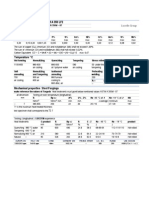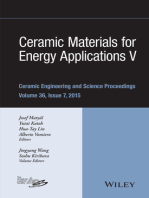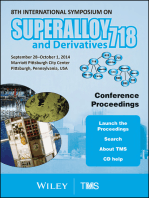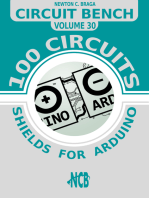1 8550-34CrAlNi710
1 8550-34CrAlNi710
Uploaded by
Michel PortalCopyright:
Available Formats
1 8550-34CrAlNi710
1 8550-34CrAlNi710
Uploaded by
Michel PortalOriginal Description:
Original Title
Copyright
Available Formats
Share this document
Did you find this document useful?
Is this content inappropriate?
Copyright:
Available Formats
1 8550-34CrAlNi710
1 8550-34CrAlNi710
Uploaded by
Michel PortalCopyright:
Available Formats
Quality 34CrAlNi7-10 Nitriding Technical card
According to standard UNI EN 10085: 2003 Steel Lucefin Group
Number 1.8550 rev. 2018
Chemical composition
C% Si% Mn% P% S% Cr% Mo% Ni% Al%
max max max Product deviations
0,30-0,37 0,40 0,40-0,70 0,025 0,035 1,50-1,80 0,15-0,25 0,85-1,15 0,80-1,20 are allowed
± 0.02 + 0.03 ± 0.04 +0.005 + 0.005 ± 0.05 ± 0.03 ± 0.05 ± 0.10
Temperature °C
Hot-forming Stress-relieving Quenching Tempering Nitrocarburizing Final stress-relieving
after machining +Q +T +SR
1050-850 550-580 850-890 570-660 570-580 50° under the
air oil or polymer air temperature of tempering
Soft Ion Nitriding End quench Pre-heating welding Stress-relieving
annealing +A Nitriding hardenability test after welding
650-700 450-490 500-520 900 300 550 furnace cooling
air controlled atm. water AC1 AC3 MS Mf
(HB max 248) (HV 1000-1100) (HV 940) 765 830 340 125
Mechanical properties
Hot-rolled mechanical properties in quenched and tempered condition UNI EN 10085: 2003
size mm Testing at room temperature (longitudinal)
R Rp 0.2 A% Kv HB Surface hardness in
from to N/mm2 N/mm2 min. min. J min. for information quenched and tempered
16 40 900-1100 680 10 30 271-331 and nitrided condition
40 100 850-1050 650 12 30 253-319 HV 1
100 160 800-1000 600 13 35 240-298 950
160 250 800-1000 600 13 35 240-298
Table of tempering values obtained at room temperature on rounds of Ø 10 mm after quenching at 880 °C in oil
HB 534 534 525 518 504 489 468 448 432 404 376 327 294 271
HRC 53.5 53.5 53 52.5 51.5 50.5 49 47.5 46 43.5 40.5 35 31 28
R N/mm2 1970 1970 1950 1900 1850 1800 1710 1620 1520 1400 1280 1090 980 900
Rp 0.2 N/mm2 1440 1450 1520 1570 1550 1500 1440 1390 1300 1210 1100 970 820 700
A % 9.8 10.0 10.0 10.0 10.0 10.0 10.0 10.0 10.4 11.2 13.6 15.5 18.4 -
Z % 38 40 43 43 42 40 39 40 43 45 50 57 63 -
Kv J 8 11 11 8 7 6 5 4 6 8 17 38 84 152
Tempering at °C 50 100 150 200 250 300 350 400 450 500 550 600 650 700
High-temperature testing
R N/mm2 840 780 760 790 700 580 350
Rp 0.2 N/mm2 620 590 580 560 480 410 220
A % 22 22 22 22 24 26 28
C % 68 70 68 64 76 80 88
Kv J 140 150 165 175 150 125 80
Test temperature °C 20 100 200 300 400 500 600
Nitriding. Hardness HV, at different depths and stays
30 860 520 400 360 360 350 350
stay time 90 930 860 710 540 420 350 350
h. 120 930 860 720 640 540 430 350
180 940 860 760 720 650 560 350
depth mm 0,15 0,25 0,35 0,45 0,55 0,65 1,0
34CrAlNi7-10 Lucefin Group
Cold-drawn Hot-rolled + Peeled
size mm Testing at room temperature (longitudinal) Testing at room temperature (longitudinal)
R Rp 0.2 A% HB R Rp 0.2 A% HB
from to N/mm2 N/mm2 min min N/mm2 N/mm2 min min
No indications from reference standards No indications from reference standards
Forged mechanical properties in quenched and tempered condition UNI EN 10085: 2003
size mm Testing at room temperature (longitudinal)
R Rp 0.2 A% Kv HB
from to N/mm2 N/mm2 min min J min for information
100 850-1050 650 12 30 253-319
100 160 800-1000 600 13 35 240-298
160 250 800-1000 600 13 35 240-298
Jominy test HRC 34CrAlNi7 UNI 8552. Use only as reference
mm distance from quenched end
1.5 3 5 7 9 11 13 15 20 25 30 35 40 45 50
min 48.5 48 47.5 46.5 45.5 44.5 43.5 43 39 37 34.5 33 32 31.5 31
max 59.5 59 58 57 56.5 56 55.5 55 54 52 50.5 48.5 47 46 45
Thermal Expansion 10-6 ● K-1 ► 11.1 12.1 12.9 13.5 13.9
Mod. of Elasticity long. GPa 210 205 185 165 155
Mod. of Elasticity tang. GPa 80 79 71 63 59
Specific Heat Capacity J/(Kg●K) 460
Thermal Conductivity W/(m●K) 35
Density Kg/dm3 7.85
Specific Electric Resist. Ohm●mm2/m 0.31
Electrical Conductivity Siemens●m/mm2 3.22
°C 20 100 200 300 400 500 600
The symbol ►indicates temperature between 20 °C and 100 °C, 20 °C and 200 °C …
EUROPE ITALY CHINA GERMANY FRANCE U.K. RUSSIA USA
EN UNI GB DIN AFNOR B.S. GOST AISI/SAE
34CrAlNi7-10 34CrAlNi7-10 34CrAlNi7 34H2NMJu K52440
Iron/Nitrogen equilibrium diagram
As operating in continuous flow conditions, at
temperatures higher than 480 °C gaseous
ammonia releases nitrogen and hydrogen, that
are absorbed and diffused in the sub-superficial
steel layer.
Nitrogen reacts with steel elements and creates
very hard but very fragile nitrides.
The lack of alloy elements in carbon steel
causes the creation of iron nitrides only, thus
giving steel significant fragility.
To prevent this inconvenient, steels containing
Al, V, Cr, Mo (more similar to nitrogen than to
iron) are used.
Maximum temperature suggested for nitriding is
580 °C, avoiding the eutectoid of 590 °C.
Fe4 N = ferrite micro-crystals and nitrides
Fe2-3 N = nitrides behaving like a barrier against
(Can L. Richards, Technical report. University of Missouri – Rolla. the diffusion of nitrose.
www.metalquality.it)
You might also like
- Quality 1.4021 Chemical Composition: Lucefin GroupNo ratings yetQuality 1.4021 Chemical Composition: Lucefin Group2 pages
- 1.6523 - 20NiCrMo2-2 - SAE 8620 - 21NiCrMo2 - SS-2506 - SFS-506 - Datasheet - 1No ratings yet1.6523 - 20NiCrMo2-2 - SAE 8620 - 21NiCrMo2 - SS-2506 - SFS-506 - Datasheet - 12 pages
- Advances in Solid Oxide Fuel Cells and Electronic CeramicsFrom EverandAdvances in Solid Oxide Fuel Cells and Electronic CeramicsNo ratings yet
- Modern Glass CharacterizationFrom EverandModern Glass CharacterizationMario AffatigatoNo ratings yet
- Processing, Properties, and Design of Advanced Ceramics and CompositesFrom EverandProcessing, Properties, and Design of Advanced Ceramics and CompositesGurpreet SinghNo ratings yet
- Advances in Solid Oxide Fuel Cells XFrom EverandAdvances in Solid Oxide Fuel Cells XMihails KusnezoffNo ratings yet
- Ceramic Materials for Energy Applications V: A Collection of Papers Presented at the 39th International Conference on Advanced Ceramics and CompositesFrom EverandCeramic Materials for Energy Applications V: A Collection of Papers Presented at the 39th International Conference on Advanced Ceramics and CompositesJosef MatyášNo ratings yet
- Proceedings of the 8th International Symposium on Superalloy 718 and DerivativesFrom EverandProceedings of the 8th International Symposium on Superalloy 718 and DerivativesNo ratings yet
- Ceramics for Environmental SystemsFrom EverandCeramics for Environmental SystemsLianzhou WangNo ratings yet
- Ceramics for Energy Conversion, Storage, and Distribution SystemsFrom EverandCeramics for Energy Conversion, Storage, and Distribution SystemsThomas PfeiferNo ratings yet
- Big Ideas Math Geometry with CalcChat and CalcViewNo ratings yetBig Ideas Math Geometry with CalcChat and CalcView1 page
- MID 039 - CID 0171 - FMI 04: TroubleshootingNo ratings yetMID 039 - CID 0171 - FMI 04: Troubleshooting4 pages
- Bonding, structure and the properties of matterNo ratings yetBonding, structure and the properties of matter11 pages
- 1.2 Physical Qualtities CIE IAL Physics MS Theory UnlockedNo ratings yet1.2 Physical Qualtities CIE IAL Physics MS Theory Unlocked6 pages
- CCSI Aerial Fig 8 Cable 6-24F Spec Rev1 STDNo ratings yetCCSI Aerial Fig 8 Cable 6-24F Spec Rev1 STD2 pages
- Electric Current & Energy CH 17.2 8thNo ratings yetElectric Current & Energy CH 17.2 8th25 pages
- Natural Sciences Admissions Assessment (NSAA) Content SpecificationNo ratings yetNatural Sciences Admissions Assessment (NSAA) Content Specification62 pages
- 12th Chemistry Full Study Material em PDFNo ratings yet12th Chemistry Full Study Material em PDF258 pages
- Self-Limiting Parallel Heating Tape HSB: Areas of Application 1. Conductors: Stranded Copper WireNo ratings yetSelf-Limiting Parallel Heating Tape HSB: Areas of Application 1. Conductors: Stranded Copper Wire3 pages
- Weights: A Spring Is Placed On A Flat Surface and Different Weights Are Placed On It, As Shown in Fig. 2.1No ratings yetWeights: A Spring Is Placed On A Flat Surface and Different Weights Are Placed On It, As Shown in Fig. 2.120 pages
- Experiment 3 Energy Transformation: Laboratory ReportNo ratings yetExperiment 3 Energy Transformation: Laboratory Report10 pages
- 200 A 600 V Standard Enclosure: BQ2 SeriesNo ratings yet200 A 600 V Standard Enclosure: BQ2 Series12 pages
- Introduction To Millimeter-Wave Technology: Mrinal Kanti MandalNo ratings yetIntroduction To Millimeter-Wave Technology: Mrinal Kanti Mandal42 pages
- Cairo University, Faculty of Science, Mathematics DepartmentNo ratings yetCairo University, Faculty of Science, Mathematics Department4 pages

























































































